
Raymond Williams
REALISM AND THE
CONTEMPORARY NOVEL
The centenary of "realism" as an English critical term oc–
curred but was not celebrated in 1956. Its history, in this hundred
years, has been so vast, so complicated and so bitter that any celebra–
tion would in fact have turned into a brawl. Yet realism is not an
object, to be identified, pinned down, and appropriated. It is, rather,
a way of describing certain methods and attitudes, and the descrip–
tions, quite naturally, have varied, in the ordinary exchange and
development of experience. Recently, I have been reconsidering these
descriptions, as a possible way of defining and generalizing certain
personal observations on the methods and substance of contemporary
fiction. I now propose to set down: first, the existing variations in
"realism" as a descriptive term; second, my own view of the ways
in which the modem novel has developed; third, a possible new
meaning of realism.
There has, from the beginning, been a simple technical use of
"realism," to describe the precision and vividness of a rendering in
art
of some observed detail. In fact, as we shall see, this apparently simple
use involves all the later complexities, but it seemed, initially, suf–
ficiently accurate to distinguish one technique from others: realism
as opposed to idealization or caricature. But, also from the begin–
ning, this technical sense was flanked by a reference to content: cer–
tain kinds of subject were seen as realism, again by contrast with
different kinds. The most ordinary definition was
in
terms of an or–
dinary, contemporary, everyday reality, as opposed to traditionally
heroic, romantic or legendary subjects. In the period since the Renais–
sance, the advocacy and support of this "ordinary, everyday, contem–
porary reality" have been normally associated with the
rising
middle


